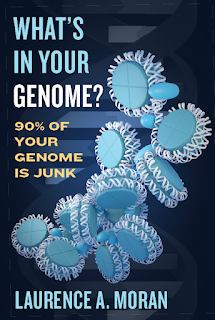Santi Garcia-Vallvé has reviewed my book in the journal Mètode. It's written in Catalan but Santi was kind enough to send me a translation.
OUR GENOME HAS NOT YET SPOKEN ITS LAST WORDWhat's in Your Genome? 90% of Your Genome Is Junk. Laurence A. Moran. Aevo University of Toronto Press (UTP). May 2023. 392 pages.
What's in Your Genome? exposes a variety of topics and concepts in molecular biology, genetics, and evolution that have been misunderstood by scientists and the general public. Many of these concepts are widely accepted, despite ongoing debate about them. Although the author, Larry Moran, has exhaustively discussed most of these issues on his blog "Sandwalk: Strolling with a sceptical biochemist", discussing them in a book allows for a more in-depth investigation.
One of these recurring themes is Francis Crick 's 1957 proposal of the Central Dogma of Molecular Biology. In his book Molecular Biology of the gene, James Watson adapted this concept by summarizing in a figure the flow of genetic information from DNA to RNA and then to proteins. This version was widely adopted, and many scientists now assume that it was the original definition. However, Crick claimed that once the information had been transferred to the proteins, it could not be returned to nucleic acids. Other controversial topics discussed in the book include the number of genes encoded in the human genome, the concept of Junk DNA and the prevalence of alternative splicing in the transcription of the human genome. Larry takes a certain viewpoint on all these problems, as evidenced by the title of the book, but he also presents arguments from all sides. Throughout the book, he argues that scientists must present evidence in support of and against their findings, as well as contextualise their discoveries in light of the knowledge of the subject. Thus, the first chapters of the book describe in depth the basic ideas of genetics, genetics and evolution that are required to understand the arguments that he will present later, showing also when and how they were discovered.
This is a highly recommendable book that pushed us to think about how research findings are explained and the importance of placing them in their proper context. The media frequently looks for stunning headlines and there is growing demand to assess the social impact of a project, article or scientific project. However, if we exaggerate our findings, we risk exacerbating further diminishing the general lack of interest in scientific news. Everyone is responsible that this does not happen.
Santi Garcia-Vallvé is an associate professor in the Department of Biochemistry and Biotechnology at Rovira i Virgili University (URV) in Tarragona, Spain, and a member of the Chemoinformatics and Nutrition research group."









